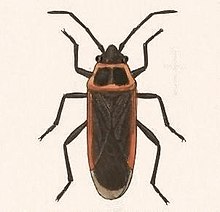Lygaeidae
| Lygaeidae | |
|---|---|

| |
| Acroleucus brevicollis | |
| Scientific classification | |
| Domain: | Eukaryota |
| Kingdom: | Animalia |
| Phylum: | Arthropoda |
| Class: | Insecta |
| Order: | Hemiptera |
| Suborder: | Heteroptera |
| Infraorder: | Pentatomomorpha |
| Superfamily: | Lygaeoidea |
| Family: | Lygaeidae Schilling, 1829 |
| Diversity | |
| at least 110 genera | |
The Lygaeidae are a family in the Hemiptera (true bugs), with more than 110 genera in four subfamilies. The family is commonly referred to as seed bugs, and less commonly, milkweed bugs, or ground bugs.[1] However, while many of the species feed on seeds, some feed on sap (mucivory) or seed pods, others are omnivores and a few, such as the wekiu bug, are carnivores that feed exclusively on insects.[2][3] Insects in this family are distributed across the world.[4] The family was vastly larger, but numerous former subfamilies have been removed and given independent family status, including the Artheneidae, Blissidae, Cryptorhamphidae, Cymidae, Geocoridae, Heterogastridae, Ninidae, Oxycarenidae and Rhyparochromidae, which together constituted well over half of the former family.[5][6]
The bizarre and mysterious beetle-like Psamminae were formerly often placed in the Piesmatidae, but this is almost certainly incorrect. Their true affiliations, however, are not entirely resolved to satisfaction.[7]
Distinguishing Characteristics[edit]
Lygaeidae are oval or elongate in body shape and have four-segmented antennae.[8] Lygaeidae can be distinguished from Miridae (plant bugs) by the presence of ocelli, or simple eyes. They are distinguished from Coreidae (squash bugs) by the number of veins in the membrane of the front wings, as Lygaeidae have only four or five veins.[9]
Subfamilies and selected genera[edit]
An incomplete list of Lygaeidae genera is subdivided as:[10][11]
- subfamily Ischnorhynchinae Stål, 1872
- Crompus Stål, 1874
- Kleidocerys Stephens, 1829
- subfamily Lygaeinae Schilling, 1829
- Lygaeus Fabricius, 1794
- Oncopeltus Stål, 1868
- Melanocoryphus Stål, 1872
- Spilostethus Stål, 1868
- Tropidothorax Bergroth, 1894
- subfamily Orsillinae Stål, 1872
- subfamily † Lygaenocorinae
- Unplaced genera
- Lygaeites Heer, 1853
The Pachygronthinae Stål, 1865 (type genus Pachygrontha Germar, 1840) may be placed here[10] or elevated to the family Pachygronthidae.[11]
Gallery[edit]
-
False milkweed bug, Lygaeus turcicus, on Asteraceae flower
-
Small milkweed bug, Lygaeus kalmii), nymph (bottom) and mature (top)
-
Large milkweed bug, Oncopeltus fasciatus, on a butterfly weed
-
Oncopeltus varicolor ssp. stalii
References[edit]
- ^ Edde, Peter A. (27 August 2021). "2 - Arthropod pests of sunflower (Helianthus annuus L.)". Field Crop Arthropod Pests of Economic Importance: 74–139. doi:10.1016/B978-0-12-818621-3.00009-4. ISBN 9780128186213.
- ^ Gillespie, David R. (1 January 2017). "Omnivory – A Flexible Feeding Strategy". Reference Module in Life Sciences. doi:10.1016/B978-0-12-809633-8.12260-5. ISBN 9780128096338.
- ^ Eiben, Jesse A.; Rubinoff, Daniel (December 2010). "Life history and captive rearing of the Wekiu bug (Nysius wekiuicola, Lygaeidae), an alpine carnivore endemic to the Mauna Kea volcano of Hawaii". Journal of Insect Conservation. 14 (6): 701–709. doi:10.1007/s10841-010-9298-y. S2CID 44239028.
- ^ "Family Lygaeidae - Seed Bugs". bugguide.net.
- ^ Henry, T.J. (1997). "Phylogenetic analysis of family groups within the infraorder Pentatomomorpha (Hemiptera: Heteroptera), with emphasis on the Lygaeoidea". Annals of the Entomological Society of America. 90 (3): 275–301. doi:10.1093/aesa/90.3.275.
- ^ Cassis G., Gross G.F. (2002). Zoological Catalogue of Australia: Hemiptera: Heteroptera (Pentatomomorpha). CSIRO Publishing. p. 157. ISBN 9780643068759.
- ^ David A. Grimaldi & Michael S. Engel (2007). "An unusual, primitive Piesmatidae (Insecta: Heteroptera) in Cretaceous amber from Myanmar (Burma)" (PDF). American Museum Novitates (3611): 1–17. doi:10.1206/0003-0082(2008)3611[1:AUPPIH]2.0.CO;2. S2CID 86107041.
- ^ Slater, James Alexander (1995). A catalogue of the Lygaeidae of the world (1960-1994). New York, N.Y.: New York Entomological Society. ISBN 978-0-913-424-16-2.
- ^ "Family Lygaeidae". ENT 425 - General Entomology.
- ^ a b BioLb.cz: family ground bugs: Lygaeidae Schilling, 1829 (retrieved 26 October 2021)
- ^ a b Dellapé, Pablo M.; Henry, Thomas J. (2019). "family Lygaeidae Schilling, 1829". Lygaeoidea Species File. Retrieved 2019-06-19.
External links[edit]
- Lygaeidae, BugGuide




